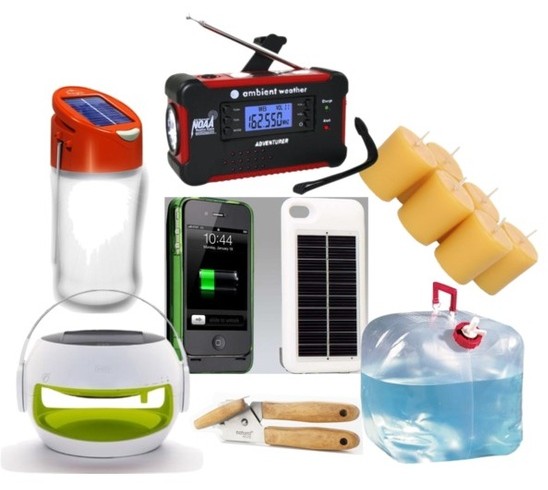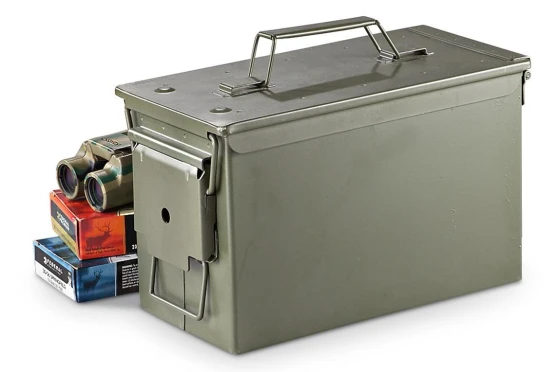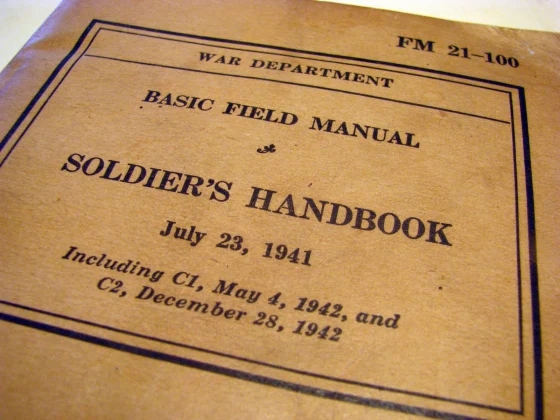Contents:
- Lead Acid Batteries
- Alkaline Batteries
- Nickel Metal Hydride Batteries
- Nickel Cadmium Batteries
- Primary Lithium Cells
- Storacell’s “Battery Caddies” Battery Storage Devices
General Thoughts:
- Battery School
- Battery Basics: Are You Prepared
- Understanding Battery Life
- Electrical Conversion
- Uses For Dead Car Batteries And Sealed Lead Acid Batteries
back to top
Lead Acid Batteries:
Characteristics:
- Lead acid batteries were invented in 1859 by Gaston Planté and first demonstrated to the French Academy of Sciences in 1860. They remain the technology of choice for automotive SLI (Starting, Lighting and Ignition) applications because they are robust, tolerant to abuse, tried and tested and because of their low cost. For higher power applications with intermittent loads however, Lead acid batteries are generally too big and heavy and they suffer from a shorter cycle life and typical usable power down to only 50% Depth of Discharge (DOD). Despite these shortcomings Lead acid batteries are still being specified for PowerNet applications (36 Volts 2 kWh capacity) because of the cost, but this is probably the limit of their applicability and NiMH and Li-Ion batteries are making inroads into this market. For higher voltages and cyclic loads other technologies are being explored.
- Lead-acid batteries are composed of a Lead-dioxide cathode, a sponge metallic Lead anode and a Sulphuric acid solution electrolyte. This heavy metal element makes them toxic and improper disposal can be hazardous to the environment.
- The cell voltage is 2 Volts.
- During discharge, the lead dioxide (positive plate) and lead (negative plate) react with the electrolyte of sulfuric acid to create lead sulfate, water and energy.
- During charging, the cycle is reversed: the lead sulfate and water are electro-chemically converted to lead, lead oxide and sulfuric acid by an external electrical charging source.
- The lead acid battery still retains the lion’s share of the high power battery market.
Advantages:
- Low cost.
- Reliable. Over 140 years of development.
- Robust. Tolerant to abuse.
- Tolerant to overcharging.
- Low internal impedance.
- Can deliver very high currents.
- Indefinite shelf life if stored without electrolyte.
- Can be left on trickle or float charge for prolonged periods.
- Wide range of sizes and capacities available.
- Many suppliers world wide.
- The world’s most recycled product.
Shortcomings:
- Very heavy and bulky.
- Typical coulombic charge efficiency only 70% but can be as high as 85% to 90% for special designs.
- Danger of overheating during charging
- Not suitable for fast charging
- Typical cycle life 300 to 500 cycles .
- Must be stored in a charged state once the electrolyte has been introduced to avoid deterioration of the active chemicals.
- Gassing is the production and release of bubbles of hydrogen and oxygen due to the breakdown of water in the electrolyte during the charging process, particularly due to excessive charging, causing loss of electrolyte. In large battery installations this can cause an explosive atmosphere in the battery room. Because of the loss of electrolyte, Lead acid batteries need regular topping up with water. Sealed batteries however are designed to retain and recombine these gases.
- Sulphation may occur if a battery is stored for prolonged periods in a completely discharged state or very low state of charge, or if it is never fully charged, or if electrolyte has become abnormally low due to excessive water loss from overcharging and/or evaporation. Sulphation is the increase in internal resistance of the battery due to the formation of large lead sulphate crystals which are not readily reconverted back to lead, lead dioxide and sulphuric acid during re-charging. In extreme cases the large crystals may cause distortion and shorting of the plates. Sometimes sulphation can be corrected by charging very slowly (at low current) at a higher than normal voltage.
- Completely discharging the battery may cause irreparable damage.
- Shedding or loss of material from the plates may occur due to excessive charge rates or excessive cycling. The result is chunks of lead on the bottom of the cell, and actual holes in the plates for which there is no cure. This is more likely to occur in SLI batteries whose plates are composed of a Lead “sponge”, similar in appearance to a very fine foam sponge. This gives a very large surface area enabling high power handling, but if deep cycled, this sponge will quickly be consumed and fall to the bottom of the cells.
- Toxic chemicals
- Very heavy and bulky
- Lead acid batteries can work down to temperatures below -45 °C, however, like all batteries the discharge rate and effective capacity are reduced at low temperatures. In the case of Lead acid batteries the capacity falls by about 1% per degree for temperatures below +20 °C so that at the lowest temperatures cranking capacity is seriously impaired.
- Decomposition of the Electrolyte Cells with gelled electrolyte are prone to deterioration of the electrolyte and unexpected failure. Such cells are commonly used for emergency applications such as UPS back up in case of loss of mains power. So as not to be caught unawares by an unreliable battery in an emergency situation, it is advisable to incorporate some form of regular self test into the battery.
Charging:
- Charge immediately after use.
- Lasts longer with partial discharges.
- Charging method: constant voltage followed by float charge.
- Fast charge not possible.
Applications:
- Automotive and traction applications.
- Standby/Back-up/Emergency power for electrical installations.
- Submarines
- UPS (Uninterruptible Power Supplies)
- Lighting
- High current drain applications.
- Sealed battery types available for use in portable equipment.
Absorbed Glass Mat Battery (AGM):
- This construction is very robust and able to withstand severe shock and vibration and the cells will not leak even if the case is cracked.
- AGM batteries are also sometimes called “starved electrolyte” or “dry”, because the fibreglass mat is only 95% saturated with Sulfuric acid and there is no excess liquid.
- Nearly all AGM batteries are sealed valve regulated “VRLA”.
- AGM’s have a very low self-discharge rate of from 1% to 3% per month.
SLI Batteries (Starting Lighting and Ignition):
- This is the typical automotive battery application. Automotive batteries are designed to be fully charged when starting the car.
- After starting the vehicle, the lost charge, typically 2% to 5% of the charge, is replaced by the alternator and the battery remains fully charged. These batteries are not designed to be discharged below 50% Depth of Discharge (DOD) and discharging below these levels can damage the plates and shorten battery life.
Deep Cycle Batteries:
- Marine applications, golf buggies, fork lift trucks and electric vehicles use deep cycle batteries which are designed to be completely discharged before recharging.
- Because charging causes excessive heat which can warp the plates, thicker and stronger or solid plate grids are used for deep cycling applications.
- Normal automotive batteries are not designed for repeated deep cycling and use thinner plates with a greater surface area to achieve high current carrying capacity.
- Automotive batteries will generally fail after 30-150 deep cycles if deep cycled, while they may last for thousands of cycles in normal starting use (2-5% discharge).
- If batteries designed for deep cycling are used for automotive applications they must be “oversized” by about 20% to compensate for their lower current carrying capacity.
back to top
Alkaline Batteries:
Characteristics:
- Many battery chemistries use alkaline electrolytes but “Alkaline Batteries” usually refers to the Alkaline Manganese Dioxide primary cells described below.
- Most popular premium general purpose battery.
- In an alkaline cell the electrical energy is essentially derived from the reaction of a metal with oxygen.
- Potassium hydroxide is the electrolyte used in most primary alkaline cells and Nickel based rechargeable cells such as NiCad and NiFe cells. It is also one of the main ingredients in household bleach, drain cleaners and soft soaps.
Advantages:
- Four times the capacity of a equivalent size rechargeable Nickel Cadmium or Nickel Metal Hydride cells.
- Constant capacity over a wide range of current drains.
- Suitable for high drain rate applications.
- Good shelf life
- Better low temperature performance than zinc carbon. Continue to function in sub-zero temperatures.
- Less leakage than Leclanché cells.
- Available in a wide range of sizes including AAA, AA, C, D and 9Volt sizes.
- Suitable for a wide range of consumer applications
- Made from non toxic chemicals.
Disadvantages:
- Higher cost than the basic competing zinc carbon Leclanché cells
- Not normally rechargeable
- 25% heavier than Leclanché cells
- RAM cells have limited cycle life of about 100 cycles and are only available in AA and AAA sizes.
Applications:
- Premium products
- Toys
- Remote controls
- Flashlights
- Clocks
- Consumer applications
- RAM cells can be interchanged with standard alkaline cells (but not mixed in the same application).
Costs:
- Low cost but about 50% higher than zinc carbon, however these cells are more cost effective because of the longer life.
- Alkaline cells have now largely replaced Zinc- Carbon primary cells.
Characteristics
- Nickel-metal-hydride batteries are related to sealed nickel-cadmium batteries and only differ from them in that instead of cadmium, hydrogen is used as the active element at a hydrogen-absorbing negative electrode (anode). This electrode is made from a metal hydride usually alloys of Lanthanum and rare earths that serve as a solid source of reduced hydrogen that can be oxidized to form protons. The electrolyte is alkaline potassium hydroxide. Cell voltage is 1.2 Volts
- The NiMH battery was patented in 1986 by Stanford Ovshinsky, founder of Ovonics.
- The basic concept of the nickel-metal hydride cell negative electrode emanated from research on the storage of hydrogen for use as an alternative energy source in the 1970s. Certain metallic alloys were observed to form hydrides that could capture (and release) Hydrogen in volumes up to nearly a thousand times their own volume. By careful selection of the alloy constituents and proportions, the thermodynamics could be balanced to permit the absorption and release process to proceed at room temperatures and pressures.
- Now that the technology is reasonably mature, NiMH batteries have begun to find use in high voltage automotive applications. The energy density is more than double that of Lead acid and 40% higher than that of NiCads
- They accept both higher charge and discharge rates and micro-cycles thus enabling applications which were previously not practical.
- The components of NiMH batteries include a cathode of Nickel-hydroxide, an anode of Hydrogen absorbing alloys and a Potassium-hydroxide (KOH) electrolyte which are collectively more benign than the active chemicals used in rival Lithium batteries.
- Like NiCd batteries, Nickel-metal Hydride batteries are susceptible to a “memory effect” although to a lesser extent. They are more expensive than Lead-acid and NiCd batteries, but they are considered better for the environment.
Recent Developments:
- NiMH cell chemistry has had a bad press ever since the introduction of Lithium based cell chemistries. NiMH technology has not been standing still however. Unlike the consumer applications where NiMH has been almost completely replaced by Lithium ion, NiMH chemistry is still finding use in automotive applications where it is the technology of choice for powering HEVs and where it has accumulated over 10 years of trouble free service and can thus last for the lifetime of the car. The operating temperature range for NiMH cells has been extended to over 100 °C (-30 °C to + 75 °C) which far exceeds the temperature range currently achievable by Lithium cells making NiMH technology ideal for automotive use. NiMH can handle the high power levels typical in EV applications, the active chemicals are inherently safer than Lithium based cells and NiMH batteries don’t need the complex battery management systems (BMS) essential with Lithium batteries.
- Early cells were susceptible to memory effect and also suffered from high self discharge, nearly ten times worse than Lead acid or Lithium batteries, but both of these weaknesses have been overcome and it is claimed that the most recent cells can hold their charge for a year.
Advantages:
- High energy density (W/kg), about 50% better than Nicads, but only about 60% of Lithium ion.
- Low internal impedance though not as low as NiCads
- Typical cycle life is 3000 cycles.
- Can be deep cycled. (80% to 100% DOD)
- Using NiMH batteries, more than 3000 cycles at 100 % Depth of Discharge (DOD) have been demonstrated. At lower depths of discharge, for example at 4 % DOD, more than 350.000 cycles can be expected.
- Robust – NiMH batteries also tolerate over charge and over discharge conditions and this simplifies the battery management requirements.
- Flat discharge characteristic (but falls off rapidly at the end of the cycle)
Wide operating temperature range - Rapid charge possible in 1 hour
- Trickle charging can not normally be used with NiMH batteries since overcharging can cause deterioration of the battery. Chargers should therefore incorporate a timer to prevent overcharging.
- Because of potential pressure build up due to gassing they usually incorporate a re-sealable vent valve
- Reconditioning is possible.
- Environmentally friendly (No Cadmium, Mercury or Lead)
- Much safer than Lithium based cells in case of an accident or abuse due to the use of more benign active chemicals, a particularly important property in high power and automotive applications.
Shortcomings:
- High self discharge rate.
- Can be stored indefinitely either fully charged or fully discharged.
- Suffers from memory effect though not as pronounced as with NiCad batteries
- Battery deteriorates during long time storage. This problem can be solved by charging and discharging the battery several times before reuse. This reconditioning also serves to overcome the problems of the “memory” effect.
- High rate discharge not as good as NiCads
- Less tolerant of overcharging than NiCads
- As with NiCads the cells must incorporate safety vents to protect the cell in case of gas generation.
- The coulombic efficiency of nickel metal hydride batteries could be up to 85% but is typically only around 65% and diminishes the faster the charge although this is projected to improve.
- While the battery may have a high capacity it is not necessarily all available since it may only deliver full power down to 50% DOD depending on the application.
- Cell voltage is only 1.2 Volts which means that many cells are required to make up high voltage batteries. The competing Lithium cells typically have 3 times the cell voltage (3.2 Volts to 3.7 Volts) and a much higher energy density.
- Lower capacity and cell voltage than alkaline primary cells.
- Limited supplies of rare earth element Lanthanum. Mostly in China.
Charging:
- Run down fully once per month to avoid memory effect.
- Do not leave battery in charger.
- Slow charging method: Constant current followed by trickle charge.
- Rapid charging method uses dT/dt charge termination.
- Use timer cut off to avoid prolonged trickle charge.
Applications:
- Low cost consumer applications, however Lithium cells are taking over this market.
- Electric razors
- Toothbrushes
- Cameras
- Camcorders
- Mobile phones
- Pagers
- Medical instruments and equipment
- Automotive batteries
- High power static applications (Telecoms, UPS and Smart grid).
Costs:
- Originally more expensive than NiCad cells but prices are now more in line as NiMH volumes increase and the use of toxic Cadmium based cells is deprecated.
- About half the cost of Lithium ion batteries.
back to top
Nickel Cadmium Batteries:
Characteristics:
- 1.2 Volt secondary cells using an alkaline chemistry with energy density about double that of lead acid batteries.
- Invented in 1899 but only introduced in volume in the early 1960’s
- They use nickel hydroxide Ni(OH)
2for the positive electrode (cathode), cadmium Cd as the negative electrode (anode) and an alkaline potassium hydroxide KOH electrolyte. - Their small size and high rate discharge capacity made portable tools and other consumer applications practical for the first time.
- The cells are sealed and utilise a recombinant system to prevent electrolyte loss and extend the useful life.
- Once the battery of choice for low power portable products they have lost market share to the newer Nickel Metal Hydride and Lithium batteries.
Advantages:
- Low internal resistance (less than half the equivalent NiMH cells)
- High rate charge and discharge rates possible
- Up to 10C discharge rates for short periods typical
- Flat discharge characteristic (but falls off rapidly at the end of the cycle)
- Tolerates deep discharges – can be deep cycled.
- Wide temperature range (Up to 70°C)
- Typical cycle life is over 500 cycles.
- Charging process is strongly endothermic-the battery cools during charging. This makes it possible to charge very quickly, as the I2R heating and endothermic chemical reaction counteract each other.
- Rapid charge typically 2 hours, but can be as low as 10 to 15 minutes.
- The coulombic efficiency of nickel cadmium is over 80% for a fast charge but can drop to below 50% for slow charging.
- The sealed nickel-cadmium cell can be stored in the charged or discharged state without damage. It can be restored for service by recharging several charge/discharge cycles.
- The electrolyte is commonly availalable, low cost potassium hydroxide KOH.
- Available in a large variety of sizes and capacities.
Shortcomings:
- A major drawback of this technology is its susceptibility to memory effect.
- Originally, the terms memory effect or memory problem was coined to describe a cyclic memory problem where the NiCad battery would “remember” the amount of discharge for previous discharges and limit the recharge life of the battery. The problem is less prevalent with modern Ni-Cd batteries, which are designed to avoid cyclic memory issues.
- The memory effect is caused by a change in crystalline formation from the desirable small size to a large size which occurs when a NiCad battery is recharged before it is fully discharged. The growth of large crystals increases the cell impedance and can eventually prevent the battery from discharging beyond that point and/or cause rapid self-discharge of the battery.
- The growth of large crystals can be avoided by either completely discharging it each time it is used or by using a NiCad battery charger which has a built-in discharge circuit.
- Memory effect can sometimes be reversed by putting the battery through several complete discharge and recharge cycles which helps to recover the smaller crystal formations. This is called reconditioning.
- NiCad batteries are also prone to damage by overcharging.
- Low cell voltage of 1.2 Volts compared with primary alkaline cells 1.5 Volts and only quarter of the capacity of the alkaline cells.
- Self re-sealing safety vents must be incorporated to prevent damage due to overheating and pressure build up.
- Cadmium is a high cost heavy metal and its use in consumer products is now deprecated on environmental grounds.
- Gradually being phased out in favour of Nickel metal hydride and Lithium technologies which have superior energy density characteristics and performance characteristics.
Charging:
- Run down fully once per month to avoid memory effect.
- Do not leave battery in charger.
- Slow charging method: Constant current followed by trickle charge.
- Rapid charging method uses Negative delta V (NDV) charge termination.
Applications:
- Motorised equipment
- Power tools
- Two way radios
- Electric razors
- Commercial and industrial portable products
- Medical instrumentation
- Emergency lighting
- Toys
Costs:
- Relatively inexpensive for low power applications but between three and four times more expensive than lead acid for the same capacity.
back to top
Primary Lithium Cells:
Characteristics:
- Lithium is the lightest of metals and it floats on water. It also has the greatest electrochemical potential which makes it one of the most reactive of metals. These properties give Lithium the potential to achieve very high energy and power densities permitting batteries with very long useful life and small cell packages.
- Because Lithium reacts violently with water, as well as nitrogen in air, this requires sealed cells. High-rate Llithium cells build up temperature and pressure if they are short circuited or abused. Thus, the cell design needs to include safety vents, which release the pressure or rupture to prevent uncontrolled explosion.
- Typical chemistries are Lithium Manganese dioxide, Llithium Sulphur dioxide, Lithium Thionyl Chloride (see below) and Lithium Oxygen (see below) but other variants are available.
- Available cell voltages range between 3 and 4 Volts
- Cell packaging includes coin cell and cylindrical packages.
- Thin film cells based on ceramic or flexible substrates are also available.
Advantages:
- High energy density, double that of premium alkaline batteries
- Low weight
- High cell voltage
- Flat discharge characteristic
- Low self discharge
- Very long shelf life
- Very long operating life (15 to 20 years for lithium thionyl chloride)
- Wide operating temperature range ( -60 ° C to +85 ° C for lithium sulfur dioxide)
- Excellent durability
- Small cell size
Shortcomings:
- High cost
Applications:
- Computer memory protection
- Medical implants
- Heart pacemakers
- Defibrillators
- Utility meters
- Watches
- Cameras
- Calculators
- Car keys
- Security transmitters
- Smoke alarms
- Aerospace applications
- Because of its superior performance characteristics Lithium technology is replacing older, traditional technologies in an ever widening range of applications.
Costs:
- More expensive than common consumer primary Leclanché and alkaline batteries.
back to top
Storacell’s “Battery Caddies” Battery Storage Devices:
 I just purchased a bunch of Storacell’s “battery caddies” to store my vast supply of spare batteries. They have models to hold C123, AAA, AA, C, D, and 9 volt batteries. They are available in many colors, including military green, black, blaze orange, and glow-in-the-dark. You can buy models that hold over a dozen batteries for bulk storage, or smaller, more portable models that only hold four to six batteries. The smaller models are perfect for your bug-out bag, get home bag, vehicle glove box, boat box, purse, shooting bag, etc.
I just purchased a bunch of Storacell’s “battery caddies” to store my vast supply of spare batteries. They have models to hold C123, AAA, AA, C, D, and 9 volt batteries. They are available in many colors, including military green, black, blaze orange, and glow-in-the-dark. You can buy models that hold over a dozen batteries for bulk storage, or smaller, more portable models that only hold four to six batteries. The smaller models are perfect for your bug-out bag, get home bag, vehicle glove box, boat box, purse, shooting bag, etc.
I bought military green ones (pictured right) for my “tactical uses”, and blaze orange for my boat’s emergency box. I have filled mine with quality batteries, place them in small, plastic craft baggies (available at at arts & crafts stores, and in the crafts section of Walmart), and packed them away along side my flashlights in my emergency bags and in my vehicles.
Storacell on Amazon:
Amazon sell all of Storacell’s products. Amazon’s prices are a little less expensive, and you may qualify for free shipping:

































